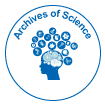Artificial Intelligence in Scientific Research: Accelerating Discovery and Innovation
Received: 01-Mar-2025 / Manuscript No. science-25-168732 / Editor assigned: 03-Mar-2025 / PreQC No. science-25-168732(PQ) / Reviewed: 17-Mar-2025 / QC No. science-25-168732 / Revised: 22-Mar-2024 / Manuscript No. science-25-168732(R) / Published Date: 28-Mar-2025
Abstract
Artificial Intelligence (AI) is revolutionizing the scientific research landscape by enhancing data analysis, accelerating discovery, and enabling predictive modeling across disciplines. From biology to astrophysics, AI tools are driving unprecedented efficiencies in hypothesis generation and experimental design. This article explores the integration of AI in various scientific domains, its role in automating research processes, and its impact on data-intensive fields such as genomics, drug discovery, and climate modeling. The article also considers ethical challenges, including data bias and transparency, while highlighting future directions that emphasize collaborative, human-AI partnerships in research.
Keywords
Artificial intelligence; Machine learning; Deep learning; Scientific discovery; Big data; Automation; Genomics; Climate modeling; Data science; Research ethics
Introduction
The integration of Artificial Intelligence (AI) into scientific inquiry marks a new era in research methodology. With the exponential growth of data, conventional analytical methods struggle to keep pace. AI, particularly machine learning (ML) and deep learning (DL), offers the capability to sift through vast datasets, identify hidden patterns, and make data-driven predictions with minimal human intervention. These technologies are being embraced across scientific domains—from automating image analysis in medical diagnostics to predicting molecular interactions in drug discovery [1]. As researchers harness AI to formulate and test hypotheses faster than ever before, the nature of scientific exploration is undergoing a profound transformation.
Description
AI applications in scientific research vary widely in scope and implementation. In life sciences, AI models analyze genomic sequences to identify gene-disease associations, predict protein folding, and even design synthetic DNA constructs [2]. DeepMind's AlphaFold, for example, has achieved near-experimental accuracy in predicting protein structures, resolving a decades-long challenge in molecular biology [3]. Similarly, in drug discovery, AI algorithms screen billions of molecular combinations to find potential therapeutic candidates, significantly reducing time and cost compared to traditional laboratory-based screening [4].
In environmental science, AI-driven climate models are being developed to simulate weather patterns, analyze satellite data, and forecast extreme climate events with higher precision [5]. These models can incorporate historical and real-time data to provide actionable insights for policy-making and disaster preparedness. In the physical sciences, AI is used in particle physics experiments such as those at CERN, where it helps classify particle collisions and detect anomalies indicative of new physical phenomena [6].
Scientific publishing and literature reviews have also been transformed by AI-powered natural language processing (NLP). Tools like Semantic Scholar and ChatGPT can summarize research papers, identify key trends, and assist in drafting scientific manuscripts. AI's capacity to interpret text, images, and numerical data makes it a versatile assistant for multidisciplinary research teams.
Furthermore, robotics and AI are converging to automate entire experiments. "Self-driving laboratories" powered by AI algorithms can conduct, analyze, and optimize experiments without human intervention. For instance, robotic chemists have been trained to synthesize and evaluate thousands of compounds autonomously, accelerating the pace of materials discovery [7].
Results
Several success stories demonstrate the transformative impact of AI on research. In drug discovery, AI platforms like BenevolentAI and Insilico Medicine have identified promising therapeutic targets for diseases including ALS and COVID-19 [8]. AlphaFold has predicted the structures of more than 200 million proteins, a feat previously considered unachievable within this timeframe. AI in astronomy has led to the discovery of new exoplanets and gravitational wave events through pattern recognition in large data streams collected by telescopes and interferometers [9].
In climate science, AI-based models such as GraphCast and ClimSim have achieved higher resolution forecasts compared to conventional models, enhancing our understanding of monsoon behavior and Arctic ice melt. Meanwhile, in agriculture, AI systems monitor crop health via drones and satellite imagery, allowing precision farming and yield optimization [10]. These advancements not only reflect increased efficiency but also democratize science by enabling researchers in low-resource settings to access powerful analytical tools.
Conclusion
Artificial Intelligence is no longer a futuristic concept in scientific research—it is a vital, evolving partner in discovery. Its applications are vast and growing, encompassing data analysis, experimental automation, and predictive modeling. However, with this power comes responsibility. Ethical considerations such as algorithmic bias, lack of transparency, and the potential for misuse must be addressed through policy frameworks and interdisciplinary dialogue. Moving forward, the vision is not to replace scientists but to augment human creativity with machine precision. As AI systems become more explainable and interoperable, the synergy between human intellect and artificial intelligence will define the next frontier in science.
Citation: Nathaniel BH (2025) Artificial Intelligence in Scientific Research:Accelerating Discovery and Innovation. Arch Sci 9: 267.
Copyright: 穢 2025 Nathaniel BH. This is an open-access article distributed underthe terms of the Creative Commons Attribution License, which permits unrestricteduse, distribution, and reproduction in any medium, provided the original author andsource are credited.
Select your language of interest to view the total content in your interested language
Share This Article
91勛圖 Journals
Article Usage
- Total views: 69
- [From(publication date): 0-0 - Aug 29, 2025]
- Breakdown by view type
- HTML page views: 45
- PDF downloads: 24
